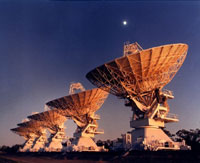Making Observations

Image: CSIRO
Astronomy differs from most sciences is that it is primarily observational rather than experimental. Our knowledge of the Universe is obtained by analysing the information we obtain from space. Most of this is in the form of electromagnetic radiation or light. Until the 1940s, astronomy was almost exclusively optical, relying on the analysis of visible light. The discovery of radio waves from space and the development of radar technology during the Second World War saw radio astronomy develop as a vital branch of astronomy. Australia was a pioneer in this discipline through the work of the CSIRO and others. With the advent of spaceflight, astronomers now observe at wavelengths including X-rays and ultraviolet that can only be detected from space. Using the enetire electromagnetic spectrum allows astronomers to gain a greater understanding of celestial objects and their interactions.
Syllabus Requirements
1. Our understanding of celestial objects depends upon observations made from Earth or from space near the Earth
- discuss Galileo’s use of the telescope to identify features of the Moon
- discuss why some wavebands can be more easily detected from space
- define the terms ‘resolution’ and ‘sensitivity’ of telescopes
- discuss the problems associated with ground-based astronomy in terms of resolution and absorption of radiation and atmospheric distortion
- outline methods by which the resolution and/or sensitivity of ground-based systems can be improved, including:
- identify data sources, plan, choose equipment or resources for, and perform an investigation to demonstrate why it is desirable for telescopes to have a large diameter objective lens or mirror in terms of both sensitivity and resolution (skill)
